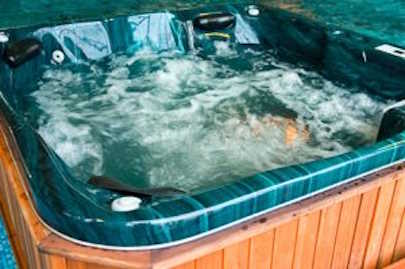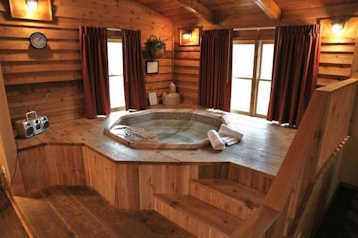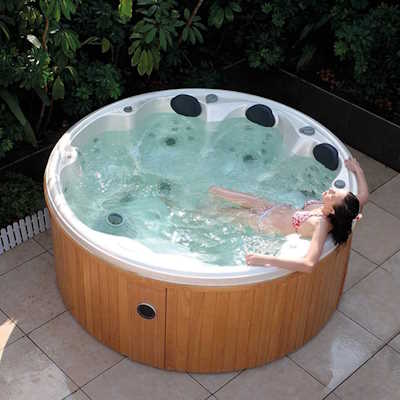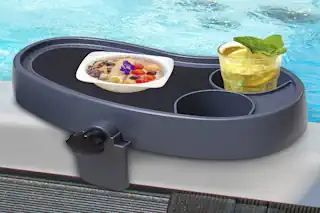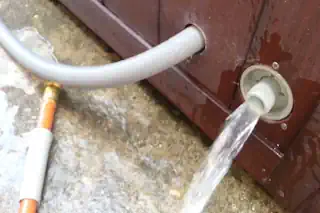The Homeowner’s Guide to Removing a Hot Tub
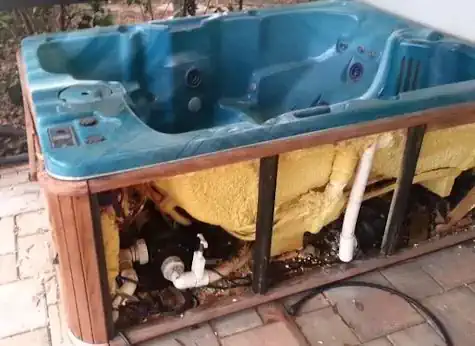
Whether you’re looking to replace that aging hot tub with a newer model, repurpose the space for something else, or just wave goodbye to high maintenance costs, removing a hot tub from your property is a substantial project. It’s not as simple as unplugging and rolling it away. This comprehensive guide is designed to walk homeowners, DIY enthusiasts, and hot tub owners through the necessary steps and considerations for safely and effectively eliminating a hot tub.
Understanding the Decision to Remove a Hot Tub
Deciding to remove a hot tub is a significant decision and one that many homeowners don’t take lightly. Some common reasons include:
The hot tub is old and not functioning properly.
There is a need to reclaim space.
The costs of running and maintaining the hot tub are no longer justifiable.
The unit is damaged beyond repair.
You want to upgrade but no one offers a trade-in program.
Once you’re certain removal is the best course of action, it’s time to move on to the next phase – preparing for the project.
Preparing for Hot Tub Removal
Before starting the removal process, ensure you have the following:
Safety goggles and gloves
A screwdriver, hammer, box cutter, and electric drill
An adjustable wrench
Hacksaw or reciprocating saw
A pump for water disposal
Ratchet straps or a dolly for moving heavy parts
A truck or trailer to haul away the hot tub
Safety should be your top concern. Hot tubs can weigh several hundred pounds and contain both electrical and plumbing elements. Turn off the power supply to the unit from the circuit breaker and enlist the help of strong and able-bodied assistants.
Step-by-Step Drainage of the Hot Tub
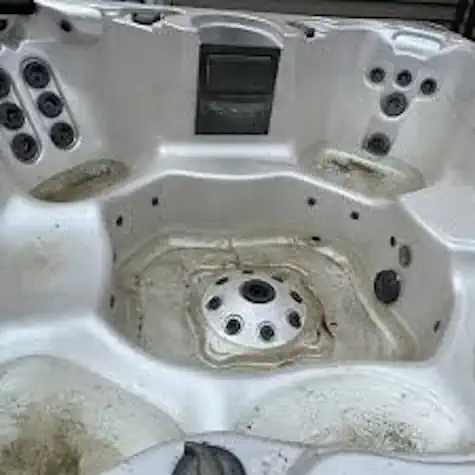
Power Down: Turn off all power to the hot tub from the circuit breaker. In some cases, it may also be necessary to shut off the water supply to the unit.
Locating Drain Plugs: Find the drain plugs on your hot tub. These are usually located on the side of the tub at the bottom.
Drain the Water: Use a pump and garden hose to remove the water from the tub. This can be a time-consuming step, depending on the size of your tub and the power of your pump. Ensure the water is directed away from your property to avoid flooding issues.
Release Remaining Water: After most of the water is drained, open the drain plugs to get the last remnants out.
Dismantling the Hot Tub
This is a labor-intensive process, and the following guidelines will help to break it down into manageable steps:
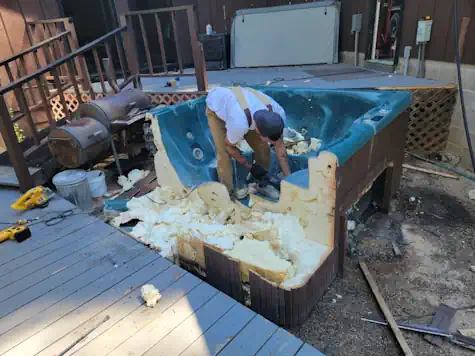
Deconstruct the Surround: If your hot tub has a wooden or composite surround, you’ll want to start by removing it. Use the screwdriver, hammer, or electric drill if the surround is particularly sturdy. If the hot tub has been in place for many years there will be accumulated deposits of dirt and other junk in the surround.
Disconnect, Detach, and Remove Accessories: Items like hot tub covers, stairs, lighting and other accessories will all need to be take off of the used hot tub before having the hot tub broken down.
Remove Panels and Siding: Take off the panels and siding to reveal the interior components. This may require the use of a screwdriver or to make it a bit easier use an electric drill.
Unscrew and Disconnect: Carefully unscrew and disconnect the electrical and plumbing components. Keep track of all the screws and hardware, as you will need to recycle or dispose of these parts properly.
Cut Through Structural Elements: Once the interior is exposed, use a hacksaw or reciprocating saw to cut through the structural supports and any other pieces that hold the hot tub together. Vinyl covering and foam inserts can be tricky to cut through so make sure you have the right tools for this task.
Disposal of Hot Tub Components
It’s crucial to properly dispose of each component, as many hot tub parts are recyclable. Here are a few pointers:
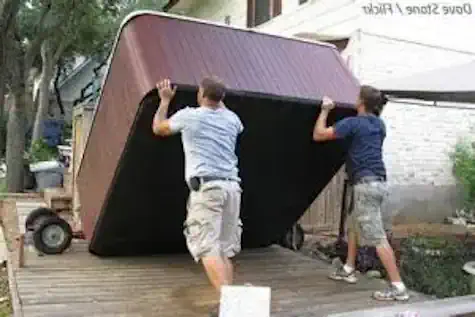
Recycling Centers: Many recycling centers accept hot tub parts, such as the shell, plumbing fixtures, covers, and even electrical components. Call ahead to confirm what they will take or ask for a free estimate.
Landfill Considerations: If recycling isn’t an option, materials like the shell, which are often made of acrylic or fiberglass, can take centuries to decompose. Check with your local landfill for proper disposal instructions.
Reuse or Resale Opportunities: If any parts of your hot tub are still in good condition, consider selling or donating them to others who may need replacement parts.
Post-Removal Cleaning and Area Restoration
With the hot tub finally removed, the key is to restore the area. Depending on your plans, you might need to level the ground, add fresh gravel, or reseed the lawn. Also, remember to:
Clean-Up Mess: The process of removing a hot tub can be messy. Clean the area thoroughly to ensure no debris is left behind.
Restore Utilities: If the hot tub was hardwired, have a licensed electrician cap off the wiring safely. If it was connected to a GFCI outlet, you’ll now have an extra outlet available for another purpose.
Consider Landscaping: Think about the aesthetics of the new space. Will you plant a garden, add a gazebo, or install a patio?
Additional Considerations and Tips
Removing a hot tub is a complex undertaking, and often it’s best to seek professional help if you’re unsure about any step in the process. There are companies that specialize in hot tub removal and can handle the entire project safely and efficiently. Here are a few additional tips:
Turn to Professionals: Especially with older hot tubs that may contain hazardous materials like asbestos or lead, professional help is strongly recommended. A junk removal service or a junk removal company will make spa removal and spa disposal quick and easy.
Protect Property Value: If you’re looking to sell your home, consider how the removal of the hot tub will affect its value. Old hot tubs, once cleaned up may be repairable for a reasonable cost. A functional hot tub will continue to add to the property value. You might need to disclose the removal in certain jurisdictions, and having a professional handle the process can provide peace of mind for both you and the future homeowner.
Familiarize With Local Regulations: Some areas have specific regulations regarding the disposal of hot tubs. Research and make sure you’re complying with all local laws and guidelines.
By following these detailed step-by-step instructions, and by paying close attention to safety and environmental concerns, homeowners can successfully remove a hot tub and turn the space into a new feature of their living environment. Remember, the key to a smooth removal is preparation and patience – take the time to do it right, and you’ll enjoy a home that’s free from its watery weight.
Frequently Asked Questions (FAQ)
How long does it usually take to remove an old spa?
The time it takes to remove an old hot tub can vary depending on its size, complexity, and how well it’s integrated into your property. On average, the process can take anywhere from a few hours to a full day.
Do I need a permit to remove my hot tub or for hot tub disposal?
Permit requirements vary by location. It’s essential to check with your local building department or municipality to determine if you need a permit for hot tub removal.
Can I remove a hot tub by myself?
While it’s possible to undertake the task alone if you have the necessary tools and experience, it’s highly recommended to have at least one other person help you due to the heavy lifting and technical aspects involved. For a one-person job, you will want to cut the hot tub into manageable pieces before trying to do all the heavy lifting to load it on a truck or trailer.
How much does it cost to have hot tubs professionally removed?
Professional hot tub removal costs can range from a few hundred to over a thousand dollars, depending on the size of the hot tub, accessibility, and disposal fees. Sometimes the money spent for professional removal is the easiest way to get the job done. In some areas there are companies who specialize in hot tub recycling which is usually included with their hot tub removal service.
What should I do if I discover hazardous materials like asbestos when removing my hot tub?
If you suspect the presence of hazardous materials, stop the removal process and contact a professional abatement service immediately. It’s crucial not to attempt the removal of hazardous materials on your own. There are many concerns here to worry about and getting hazardous materials properly disposed of can be a challenge all by itself
Can all parts of a hot tub be recycled?
Many parts of an average hot tub can be recycled, including metal components, certain plastics, and sometimes the fiberglass shell. However, recycling options may vary depending on your location, so it’s best to contact your local recycling center for specifics. Your local recycling facility will usually provide free estimates of what it will cost to get rid of an old hot tub.
What’s the best way to fill in the space left after removing my hot tub?
The best method for filling in the space depends on your future plans for the area. Options include laying sod for a lawn, installing pavers for a patio, or filling it with gravel for a low-maintenance option. Consider consulting a landscaping professional for advice tailored to your property.

